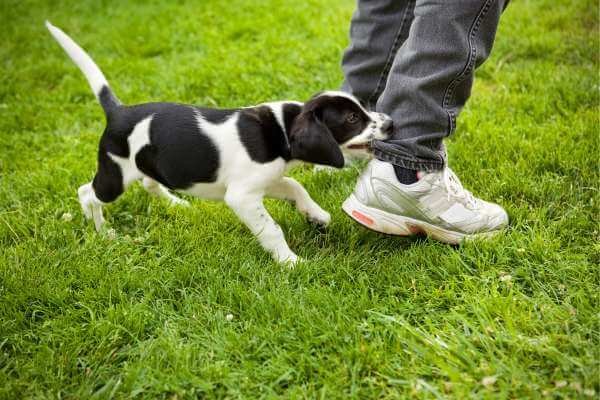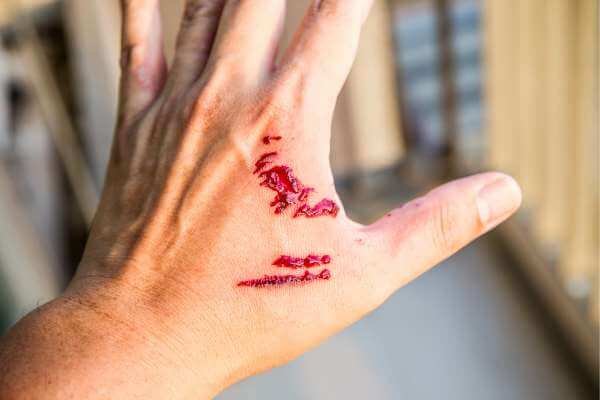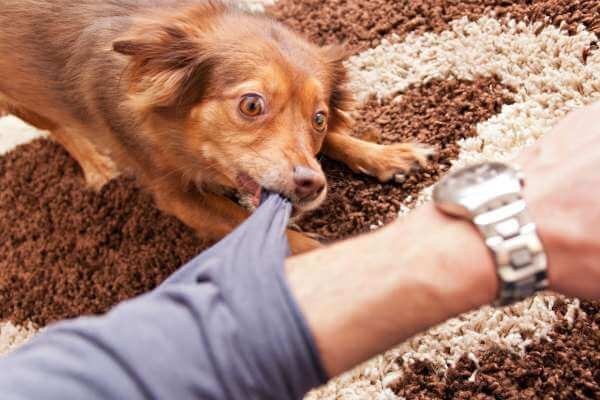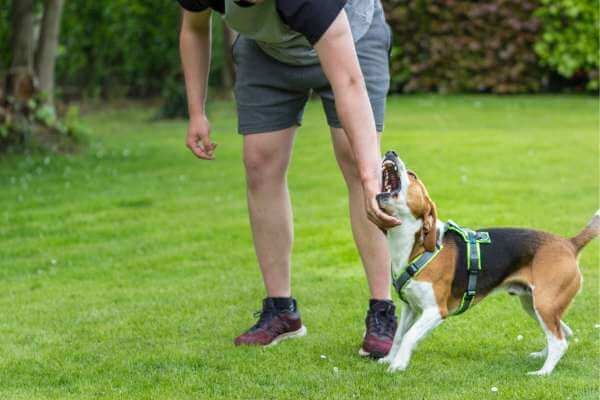Biting is a natural and normal behavior for dogs, especially when they are young and exploring the world with their mouths. However, biting can also be a serious problem that can cause injury, fear, and legal trouble. Therefore, it is essential to teach your dog not to bite people or other animals, and to control their mouth pressure and intensity. In this article, we will explain why dogs bite, how to make your dog stop biting, and what to do if your dog bites someone.
Why Dogs Bite?

Dogs bite for various reasons, depending on their age, personality, and situation. Some of the common reasons are:
Play and exploration
Puppies and young dogs bite to play and learn about their environment. They also bite to communicate with their littermates and their owners and to establish their rank and role in the pack. Biting during play and exploration is usually not aggressive or harmful, but it can still hurt and scare people, especially children. Therefore, it is important to teach your dog to play gently and appropriately with their mouth.
Teething and chewing
Puppies and young dogs bite to relieve the pain and discomfort of teething and to satisfy their natural urge to chew. Chewing helps them develop their teeth and jaws and also keeps them busy and entertained. However, if they are not provided with appropriate chew toys and outlets, they may bite and damage your furniture, shoes, or other belongings.
Fear and stress
Dogs bite when they are afraid or stressed by something or someone. They may bite to defend themselves, their territory, their owners, or their resources, such as food, toys, or bones. They may also bite when they are startled, cornered, or trapped, or when they are in pain or discomfort. Fear and stress biting is usually a sign of poor socialization, lack of confidence, or anxiety. It can also be triggered by loud noises, unfamiliar people or animals, or changes in their environment.
Dominance and aggression
Dogs bite when they are trying to assert their dominance or authority over someone or something. They may bite to challenge, intimidate, or control another dog or person, or to show their status and power in the pack. They may also bite when they are frustrated, angry, or jealous, or when they are competing for attention or resources. Dominance and aggression biting is usually a sign of poor training, lack of leadership, or hormonal imbalance. It can also be influenced by the breed, sex, or history of the dog.
How to Prevent and Stop Biting

Biting can be prevented and stopped by following some simple steps, such as:
Spay or neuter your dog
Spaying or neutering your dog can reduce their biting tendency by lowering their hormonal levels, making them less aggressive, territorial, or sexually driven. It can also improve their health, behavior, and lifespan, and prevent unwanted pregnancies or diseases.
Socialize your dog
Socializing your dog means exposing them to a variety of people, animals, and situations positively and safely, from an early age. This can help your dog learn how to behave and interact properly with others, and how to cope with different stimuli and environments. It can also prevent your dog from developing fear, stress, or anxiety, which can lead to biting.
Train your dog
Training your dog means teaching them basic commands, rules, and manners, using positive reinforcement and consistent methods. This can help your dog learn what is acceptable and unacceptable behavior, and how to control their impulses and emotions. It can also help you establish a bond of trust and respect with your dog, and make them more obedient and attentive. Some of the important commands to teach your dog are “sit”, “stay”, “come”, “leave it”, and “drop it”.
Provide enough exercise and stimulation
Providing enough exercise and stimulation means giving your dog enough physical and mental activity to keep them happy and healthy. This can help your dog burn off their excess energy, boredom, and frustration, which can cause biting. It can also keep them fit, alert, and entertained, and prevent them from developing behavioral problems. You can provide your dog with exercise and stimulation by walking, running, playing, or doing agility or obedience exercises with them. You can also provide them with toys, puzzles, games, or chew items to keep them busy and satisfied.
Correct your dog’s biting behavior
Correcting your dog’s biting behavior means teaching them that biting is not allowed and that there are consequences for doing so. You can correct your dog’s biting behavior by using one or more of the following methods:
- Yelp and stop: This method mimics how puppies learn bite inhibition from their littermates. When your dog bites you, yelp loudly and sharply, and stop playing or interacting with them. This will startle your dog and make them realize that biting hurts and ends the fun. Then, ignore your dog for a few seconds, and resume the play or interaction only if they are calm and gentle. Repeat this process until your dog learns to control their mouth pressure and intensity.
- Redirect and reward: This method redirects your dog’s biting behavior to something more appropriate and rewards them for doing so. When your dog bites you, say “no” or “ouch” firmly, and offer them a toy, a treat, or a chew item instead. This will teach your dog what they are allowed to bite and what they are not, and that biting the right thing brings positive outcomes. Then, praise your dog and continue the play or interaction with the toy, treat, or chew item. Repeat this process until your dog learns to choose the alternative over biting you.
- Time out and isolate: This method isolates your dog from any attention or stimulation and makes them associate biting with something unpleasant. When your dog bites you, say “no” or “ouch” firmly, and take them to a boring and quiet place, such as a crate, a room, or a pen. This will teach your dog that biting leads to isolation and boredom and that they lose your company and attention. Then, leave your dog alone for a few minutes, and return only if they are calm and quiet. Repeat this process until your dog learns to stop biting to avoid being isolated.
What to Do If Your Dog Bites Someone

If your dog bites someone, you should take the following steps:
Separate your dog from the victim
Immediately remove your dog from the scene, and secure them in a safe place. This will prevent further injury, aggression, or stress, and allow you to attend to the victim.
Check the victim’s injury
Check the severity and location of the bite wound, and apply first aid if needed. If the wound is minor, wash it with soap and water, apply an antibiotic ointment, and cover it with a bandage. If the wound is deep, bleeding, or infected, seek medical attention as soon as possible.
Exchange information with the victim
Exchange your name, address, phone number, and dog’s vaccination records with the victim. If the victim is a stranger, ask for their name, address, phone number, and medical insurance information. If the victim is a friend or a family member, apologize and offer to pay for any medical expenses.
Report the incident to the authorities
Report the bite incident to your local animal control agency, health department, or police department, as required by law. Provide them with the details of the incident, such as the date, time, place, circumstances, and witnesses. Cooperate with their investigation and follow their instructions.
Consult your veterinarian and a dog trainer
Consult your veterinarian to check your dog’s health, behavior, and vaccination status. Your dog may need a rabies booster or a quarantine period, depending on the situation. Consult a professional dog trainer or a behaviorist to evaluate your dog’s temperament, personality, and history. Your dog may need a behavior modification program, a muzzle, or a rehoming, depending on the severity of the bite.
Conclusion for How to Make Your Dog Stop Biting

Biting is a common and normal behavior for dogs, but it can also be dangerous and unacceptable. Therefore, it is important to understand why dogs bite, how to prevent and stop biting, and what to do if your dog bites someone. By following the steps and tips in this article, you can make your dog stop biting and become a safer and happier pet.

